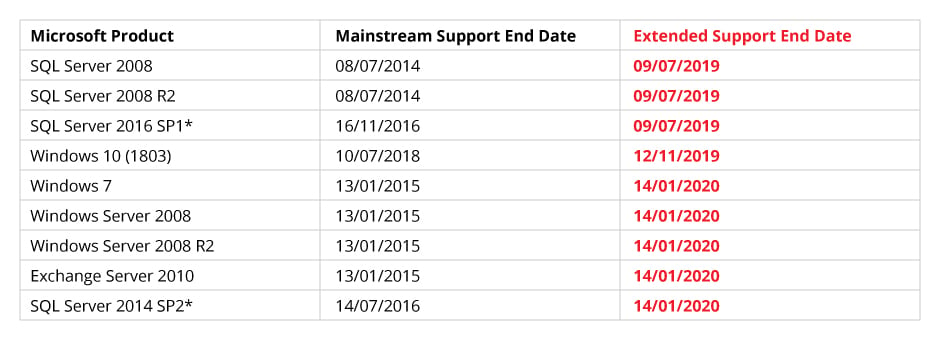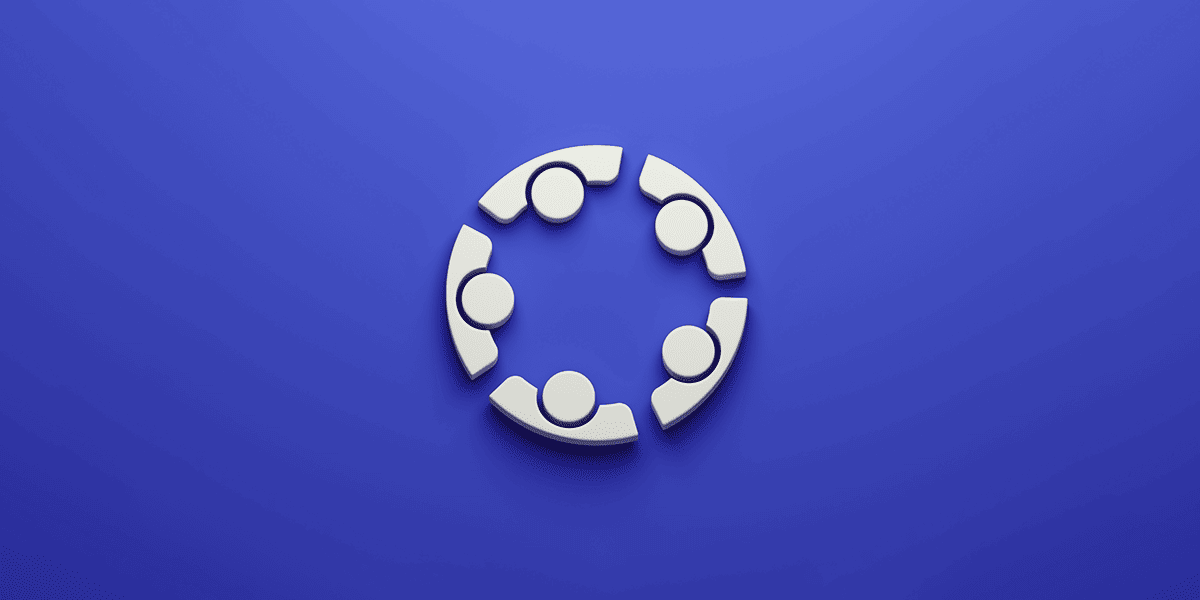Microsoft End of Support: what help is available?
Unfortunately, the shift to remote working in the face of the coronavirus is compounding the legacy systems problem. This article examines what Microsoft’s end of support means, and lists the products affected and when. He also shares his extensive knowledge of what you need to do about it.
What does Microsoft End of Support mean?
This means that once a product reaches its ‘Extended Support End Date’ there will be no patches, security updates or support from Microsoft. If you’re using any of these products and do nothing, it’s almost certain that your risks around security and compliance will increase, which may also impact productivity. These risks will only grow over time, so it’s vital you take action. We’re here to help you.
Why does Microsoft end support for its products?
In brief, they can focus their investment on supporting newer and better technologies and improved user experiences.
What Microsoft products are coming to the end of their support?
Support for several popular Microsoft products has or is ending soon, notably:
- SQL Server 2008 and 2008 R2 on 9 July 2019
- Windows Server 2008 and 2008 R2 on 14 January 2020
- Windows 7 on 14 January 2020
Act Now: Microsoft End of Support Coming Soon
If you’re using any of the products listed in the table below, you’ll find advice on your options towards the end of this blog.
 * There is a newer service pack for the SQL server version which will extend support. We recommend you upgrade to the latest service pack for the product to remain supported.
* There is a newer service pack for the SQL server version which will extend support. We recommend you upgrade to the latest service pack for the product to remain supported.
Table notes: Support ends 12 months after the next service pack release or at the end of the product’s support lifecycle, whichever comes first.
Exchange Server 2010 Extended Support End date now 13 October 2020.
All information is based on the support date for the most recent service pack for the product. Support for these products where the latest service pack is not applied has already lapsed. You can check the full details for the support milestone dates for your Microsoft products by visiting the
Microsoft Support lifecycle website.
Think Ahead: Microsoft End of Support within the next few years
Support for the Microsoft products listed below ends in less than five years time.

Table notes: Support ends 12 months after the next service pack release or at the end of the product’s support lifecycle, whichever comes first.
All information is based on the support date for the most recent service pack for the product. Support for these products where the latest service pack is not applied has already lapsed. You can check the full details for the support milestone dates for your Microsoft products by visiting the
Microsoft Support lifecycle website.
What are your options?
Fundamentally, we recommend
modernising your workplace. Get modern and up-to-date by upgrading your workloads to the latest Windows Desktop, Server or Application versions and move them to a
Modern Device or consider
Cloudlab or
Azure.
You could also consider the Microsoft Managed Desktop service (MMD)
. MMD is the fastest and potentially the cheapest way of moving from Windows 7 to Windows 10.
If there are technical reasons why you can’t modernise your workplace, you have two core options,
or you could decide to do nothing. The one you choose depends on the circumstances and needs of your organisation and users. Here are your options, together with additional information for different applications:
- Relocate your workloads to Azure: if you have an application or infrastructure constraint that’s keeping you on a legacy version, you’ll receive Extended Security Updates by running your workloads on the Azure platform.
- Complete an in-place-upgrade: If time is against you or if your connectivity inhibits your move to the cloud, then as a last resort upgrade your Windows Server 2008 and Windows Server 2008 R2. Read Microsoft’s guidance here. Consider this a short-term plan until you’re ready to modernise and simplify your IT.
- Do nothing: The sky isn’t going to fall in when Microsoft’s support ends, but your systems and applications will be increasingly vulnerable to cyber risk. Your workloads will be unsupported, and assistance will be very limited should they fail.
Advice for your end-user compute workloads – Windows 7
If you’re running Windows 7 on your desktop computers or in a VDI (virtual desktop infrastructure) environment, we strongly advise that you move to the latest Windows 10 build. This will equip your users with the most productive and secure Windows desktop to date. Windows 10 has a full feature update twice a year and gets better with each release. Seize this opportunity to take advantage of the security, productivity and management capabilities in Windows 10.
If something is preventing you from upgrading to Windows 10, you could migrate your Windows 7 workloads to Azure inside a VDI environment such as
Windows Virtual Desktop. You’ll get the Extended Security Updates for free, so your legacy workloads will be supported while you transition to Windows 10.
If you can’t move your workloads to Azure, you can buy the Extended Security Update add-on for your physical workstations. This is costly, however, and won’t mitigate the other risks of using legacy devices.
Advice For Your Server Workloads – Windows Server, SQL Server, Exchange Server
Assess the environment your server is running in – physical or virtual – and the applications running on top of your server operating system.
The modern approach is to migrate your application workloads to a Platform-as-a-Service (PaaS) or Software-as-a-Service (SaaS) environment. The cloud is evergreen and allows you to scale up or down as required, paying only for what you consume. Exchange Online, as part of Office 365 or
Azure SQL Database, are great examples of Microsoft’s modern approach to mainstream server applications.
If you need to keep your operating system running on the same version, you can migrate your workloads to Microsoft Azure and get Microsoft’s
Extended Security Updates for a further three years. Click the links to find details on how to move your
Windows Server Operating Systems and
SQL Server Applications.
You could also look at upgrading the server(s) in your offices or data-centres to newer hardware running the latest version of Windows Server. However, this is expensive when you consider the server and client access licenses as well as the power, cooling and responsibilities of maintaining your hardware. Instead, we recommend upgrading your workloads and migrating them to our
Cloudlab platform or directly to Azure.
Explore our managed cloud services
We’ve helped hundreds of organisations to modernise and move to the cloud; we have the scale, knowledge and years of experience to guide you. Our managed cloud services portfolio includes:
- Azure Public Cloud and if you’re not quite ready to make the leap, consider a phased approach;
- Hybrid Cloud – move what you can to the cloud now, while continuing to manage your legacy applications.
- Cloudlab – our highly secure, Infrastructure-as-a-Service Platform
If you’d like guidance on the best plan for your organisation or support for your journey,
contact us today.
A Quick Note About Windows 10
As mentioned, Windows 10 is updated twice a year. Microsoft maintains support for the current and previous two feature updates for Windows 10 before support is retired.
The exception to this is the Long-Term Servicing Channel (LTSB/LTSC). While Microsoft supports these releases for much longer than the semi-annual feature updates, it’s not the recommended service path for most organisations. LTSC releases are designed for regulated systems, such as workstations connected to MRI scanners where the operating system feature set cannot change.
If you’re running the LTSC releases we advise you to move away and deploy and maintain the current Semi-Annual release of Windows 10. You’ll enjoy the benefits of Microsoft’s maintained feature and security enhancements.
Microsoft End of Support: Help and Resources
So that you can quickly access trusted links and current guidance, we’ve compiled this list:
National Cyber Security Centre:
One year left for Windows 7 support
Microsoft
Windows 7 support will end on January 14, 2020
Microsoft
Lifecycle FAQ – Windows products
Microsoft
Windows for business – learn more about Windows 10 editions.
Microsoft
Prepare for SQL Server 2008 end of support – includes video.
Microsoft
Extended Security Updates frequently asked questions – about end of support for SQL Server and Windows Server 2008 and 2008 R2.
Microsoft’s
Service Pack Lifecycle Policy
Microsoft
Search by product name or time range for life cycle information
Microsoft Azure blog
Announcing new options for SQL Server 2008 and Windows Server 2008 End of Support
Microsoft Azure
Windows Virtual Desktop
Microsoft
Azure SQL Database
Microsoft Windows IT Pro Center
Upgrade Windows Server 2008 and Windows Server 2008 R2
Microsoft 16-page PDF download:
Extended Security Updates for SQL Server and Windows Server 2008/2008 R2 Frequently Asked Questions
Microsoft 1-page PDF download:
Extended Security Updates after end of support for Windows Server and SQL Server 2008 and 2008 R2
 * There is a newer service pack for the SQL server version which will extend support. We recommend you upgrade to the latest service pack for the product to remain supported.
Table notes: Support ends 12 months after the next service pack release or at the end of the product’s support lifecycle, whichever comes first. Exchange Server 2010 Extended Support End date now 13 October 2020.
All information is based on the support date for the most recent service pack for the product. Support for these products where the latest service pack is not applied has already lapsed. You can check the full details for the support milestone dates for your Microsoft products by visiting the Microsoft Support lifecycle website.
* There is a newer service pack for the SQL server version which will extend support. We recommend you upgrade to the latest service pack for the product to remain supported.
Table notes: Support ends 12 months after the next service pack release or at the end of the product’s support lifecycle, whichever comes first. Exchange Server 2010 Extended Support End date now 13 October 2020.
All information is based on the support date for the most recent service pack for the product. Support for these products where the latest service pack is not applied has already lapsed. You can check the full details for the support milestone dates for your Microsoft products by visiting the Microsoft Support lifecycle website.
 Table notes: Support ends 12 months after the next service pack release or at the end of the product’s support lifecycle, whichever comes first.
All information is based on the support date for the most recent service pack for the product. Support for these products where the latest service pack is not applied has already lapsed. You can check the full details for the support milestone dates for your Microsoft products by visiting the Microsoft Support lifecycle website.
Table notes: Support ends 12 months after the next service pack release or at the end of the product’s support lifecycle, whichever comes first.
All information is based on the support date for the most recent service pack for the product. Support for these products where the latest service pack is not applied has already lapsed. You can check the full details for the support milestone dates for your Microsoft products by visiting the Microsoft Support lifecycle website.


















